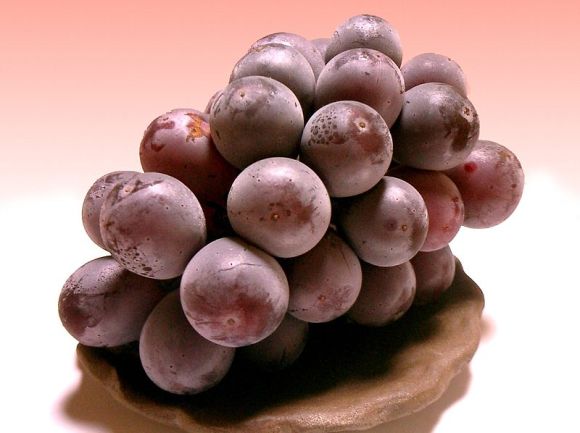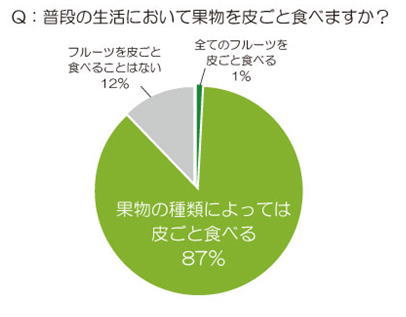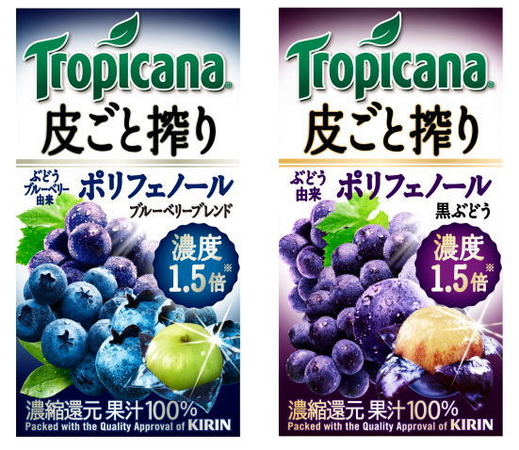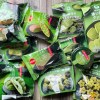
On more than one occasion, when the family would settle down for a nice bowl of grapes, I would do as usual and pop one in my mouth. Almost assuredly my wife’s face would contort into a grimace that would make you think I just licked a dog’s butt. This would soon be followed by a lecture on how the pesticides used on it seep into the skin and cannot be washed off along with pleas to stop this barbaric act.
However, I figured if I haven’t died or gotten so much as a tummy ache thus far, it’s probably okay. Nevertheless, every once and a while my wife would try to slip me a peeled grape to convert me, only to have my face contort into the shape of having licked a dogs butt.
The whole point of all this dog-butt talk is that my wife is not at all alone among Japanese people who refuse to eat the skins of certain fruits. However, in recent years, this trend has been changing according to a survey by Tropicana Japan and Dr. “Fruit” Motohashi.
■ Tropicana Survey
Tropicana surveyed 1,002 women about their fruit habits and among those who regularly ate fruit 87 percent responded that they would eat the peel of certain kinds of fruit. The other 12 percent said that they don’t eat the skin of fruit at all. And then there was one percent who said they eat the skin of all fruits who were clearly lying just to feel special.
That first 87 percent was then asked what fruits they ate the skin of. Blueberries were the highest response with 76 percent of respondents eating the skins, apple came in second with 74 percent, and grape was third with only 69 percent of women not peeling.
Dr. Motohashi believes this is a recent trend in Japan because people are becoming more aware of health issues and discovering that in addition to the flesh of the fruit, the skin is an excellent source of nutrition. He reminds people that eating peeled apples deprives them of antioxidants, potassium, calcium, vitamin C, and dietary fiber. We trust him because he looks really confident.
He goes on to say that while this has only been recently studied in Japan, fruit skin nutrition has been well understood for decades in North America and Europe whose residents tend to eat it more.
■ Our Survey
Although it’s probably a move to better health with more and more Japanese people taking on the habit of eating at least some fruit peels, the numbers of the Tropicana survey still seem particularly high compared to personal experience.
So we at RocketNews24 have conducted our own survey adhering to the strictest of scientific standards and just asked anyone we happened to bump into today. While Tropicana focused solely on women, we asked all genders and age groups.
“I sometimes eat an apple with the skin, but my teeth have gaps and it’s annoying when the peel gets in between. I just don’t like the texture of grape skins.”
(Female, 50s)“I don’t like apple skin because it’s not clean and too hard. Grape skin’s also dirty but has more of a bitter taste.”
(Female, 30s)“I used to never eat grape skins because I was worried about the chemicals. Now, I mostly buy organic and even if I don’t I just take a chance and eat the whole thing. I don’t eat apples much but I always peel pear because the skin isn’t very good.”
(Male, 70s)“I don’t eat apple peels because they just don’t taste very good. I don’t like grape skins because they are too thick. It’s like eating a melon rind.”
(Male, 30s)“I never have eaten the apple’s skin just out of habit and the grape skins are too thick. However, now that I hear it’s healthy I will try to eat apple peels from now on.”
(Male, 40s)“I don’t like grape or apple skins because they’re hard to bite and they taste bitter and sour. I don’t even think of them as part of the fruit.”
(Male, 20s)“Dumbass, eating grape skins is like sucking on the barrel of a loaded gun. Enjoy the poison! Now go take out the garbage and sit next to it. Hopefully they’ll pick you up too this time.”
(My Wife, Undisclosed)
Our answers seemed to almost unanimously land in the “no way” category with only a few lukewarm interests in eating apple or grape skins. No one eats blueberries in our survey aside from yogurt toppings or pastry fillings. Needless to say, we don’t exactly roll in the healthiest of circles.
■ Conclusion
This is a rather large assumption, but if we take both the Tropicana and our survey into account it would seem that health conscious women are getting into eating fruit skins en masse. These women are perhaps the best demographic for Topicana’s new series of juice squeezed with the peel starting with “blueberry blend” and “black grape” which just happened to have been released on 8 April.
On the other hand, it would seem that many of the people on the streets are still weary of a fruit’s outer coating but perhaps open to change. On a more global scale it’s a case of one’s trash is another’s treasure. While many shun apple and grape skins in Japan, fish with its skin attached is readily available and eaten whole. I love bread heels for all their crusty goodness and yet they’re surprisingly hard to find attached to loaves of bread in any supermarket in this country. Go figure.
The world’s full of many different types of people who enjoy many different types of food in many different ways. It’s part of what makes this a wonderfully diverse planet. So, please don’t judge people based on their diets… Unless they’re one of those types who eat light bulbs and billiard balls on TV. I judge them, and they are weird.
Source: PR Times, Tropicana via Entabe (Japanese)
Top Image: Wikipedia – Tomomarusan




 Fukuoka senior arrested for stealing a single grape, denies charges
Fukuoka senior arrested for stealing a single grape, denies charges Japanese guys way more enthusiastic about moving in with girlfriends than vice-versa, survey says
Japanese guys way more enthusiastic about moving in with girlfriends than vice-versa, survey says This super-rare Japanese banana has edible skin!【Taste test】
This super-rare Japanese banana has edible skin!【Taste test】 Japanese men reveal the things they notice when they see a woman without makeup
Japanese men reveal the things they notice when they see a woman without makeup Vegetables are smarter than fruits: Three high IQ Japanese veggies
Vegetables are smarter than fruits: Three high IQ Japanese veggies Japanese ramen restaurants under pressure from new yen banknotes
Japanese ramen restaurants under pressure from new yen banknotes McDonald’s new Happy Meals offer up cute and practical Sanrio lifestyle goods
McDonald’s new Happy Meals offer up cute and practical Sanrio lifestyle goods Secret Kitchen bento serves Japanese flowers, birds, wind and moon in a box, but is it worth it?
Secret Kitchen bento serves Japanese flowers, birds, wind and moon in a box, but is it worth it? New private rooms on Tokaido Shinkansen change the way we travel from Tokyo to Kyoto
New private rooms on Tokaido Shinkansen change the way we travel from Tokyo to Kyoto We tried Korea’s way-too-big King Tonkatsu Burger at Lotteria 【Taste Test】
We tried Korea’s way-too-big King Tonkatsu Burger at Lotteria 【Taste Test】 Mt. Koya planning to instate visitor’s tax to cope with huge tourist numbers
Mt. Koya planning to instate visitor’s tax to cope with huge tourist numbers French Fries Bread in Tokyo’s Shibuya becomes a hit on social media
French Fries Bread in Tokyo’s Shibuya becomes a hit on social media Sakura tree falls on man at Sannenzaka near Kiyomizu temple in Kyoto 【Breaking News】
Sakura tree falls on man at Sannenzaka near Kiyomizu temple in Kyoto 【Breaking News】 Family Mart makes matcha dreams come true with new lineup of strong green tea sweets in Japan
Family Mart makes matcha dreams come true with new lineup of strong green tea sweets in Japan Kyoto’s 100 Demons yokai monster parade returns!
Kyoto’s 100 Demons yokai monster parade returns! All-you-can-drink Starbucks and amazing views part of Tokyo’s new 170 meter-high sky lounge
All-you-can-drink Starbucks and amazing views part of Tokyo’s new 170 meter-high sky lounge More foreign tourists than ever before in history visited Japan last month
More foreign tourists than ever before in history visited Japan last month Starbucks reopens at Shibuya Scramble Crossing with new look and design concept
Starbucks reopens at Shibuya Scramble Crossing with new look and design concept Studio Ghibli releases new action figures featuring Nausicaä of the Valley of the Wind characters
Studio Ghibli releases new action figures featuring Nausicaä of the Valley of the Wind characters Studio Ghibli glasses cases let anime characters keep an eye on your spectacles
Studio Ghibli glasses cases let anime characters keep an eye on your spectacles Is the new Shinkansen Train Desk ticket worth it?
Is the new Shinkansen Train Desk ticket worth it? Beautiful Ghibli sealing wax kits let you create accessories and elegant letter decorations【Pics】
Beautiful Ghibli sealing wax kits let you create accessories and elegant letter decorations【Pics】 Studio Ghibli releases Kiki’s Delivery Service chocolate cake pouches in Japan
Studio Ghibli releases Kiki’s Delivery Service chocolate cake pouches in Japan New definition of “Japanese whiskey” goes into effect to prevent fakes from fooling overseas buyers
New definition of “Japanese whiskey” goes into effect to prevent fakes from fooling overseas buyers Our Japanese reporter visits Costco in the U.S., finds super American and very Japanese things
Our Japanese reporter visits Costco in the U.S., finds super American and very Japanese things Studio Ghibli unveils Mother’s Day gift set that captures the love in My Neighbour Totoro
Studio Ghibli unveils Mother’s Day gift set that captures the love in My Neighbour Totoro Domino’s Japan now sells…pizza ears?
Domino’s Japan now sells…pizza ears? New Japanese KitKat flavour stars Sanrio characters, including Hello Kitty
New Japanese KitKat flavour stars Sanrio characters, including Hello Kitty New Pokémon cakes let you eat your way through Pikachu and all the Eevee evolutions
New Pokémon cakes let you eat your way through Pikachu and all the Eevee evolutions Sales of Japan’s most convenient train ticket/shopping payment cards suspended indefinitely
Sales of Japan’s most convenient train ticket/shopping payment cards suspended indefinitely Sold-out Studio Ghibli desktop humidifiers are back so Totoro can help you through the dry season
Sold-out Studio Ghibli desktop humidifiers are back so Totoro can help you through the dry season Japanese government to make first change to romanization spelling rules since the 1950s
Japanese government to make first change to romanization spelling rules since the 1950s Ghibli founders Toshio Suzuki and Hayao Miyazaki contribute to Japanese whisky Totoro label design
Ghibli founders Toshio Suzuki and Hayao Miyazaki contribute to Japanese whisky Totoro label design Doraemon found buried at sea as scene from 1993 anime becomes real life【Photos】
Doraemon found buried at sea as scene from 1993 anime becomes real life【Photos】 Tokyo’s most famous Starbucks is closed
Tokyo’s most famous Starbucks is closed One Piece characters’ nationalities revealed, but fans have mixed opinions
One Piece characters’ nationalities revealed, but fans have mixed opinions We asked a Uniqlo employee what four things we should buy and their suggestions didn’t disappoint
We asked a Uniqlo employee what four things we should buy and their suggestions didn’t disappoint Princesses, fruits, and blacksmiths: Study reveals the 30 most unusual family names in Japan
Princesses, fruits, and blacksmiths: Study reveals the 30 most unusual family names in Japan Need a whale-ly cool party idea? Make your own easy and fun banana dolphins! 【DIY】
Need a whale-ly cool party idea? Make your own easy and fun banana dolphins! 【DIY】 How to make amazing Japanese fruit flower sandwiches
How to make amazing Japanese fruit flower sandwiches Kyoto Animation arsonist’s treatments yield major advancement in skin transplantation
Kyoto Animation arsonist’s treatments yield major advancement in skin transplantation In the evolution of pens, a “banana pen” is the obvious next step
In the evolution of pens, a “banana pen” is the obvious next step Mandarin orange peels aren’t trash, they’re treasure! Three chimpi tips to reuse your mikan skins
Mandarin orange peels aren’t trash, they’re treasure! Three chimpi tips to reuse your mikan skins Hamster chills out in mandarin orange skin, looks adorable 【Video】
Hamster chills out in mandarin orange skin, looks adorable 【Video】 Japanese people reveal the six western foods they find most disgusting
Japanese people reveal the six western foods they find most disgusting “Common habits of Japan’s low earners”: What this survey tells us, and what it doesn’t
“Common habits of Japan’s low earners”: What this survey tells us, and what it doesn’t Seven Japanese beauty products recommended by Twitter that are perfect for lazy girls
Seven Japanese beauty products recommended by Twitter that are perfect for lazy girls Dole Japan awarding personalised Banana Trophies to 200 runners in this year’s Tokyo Marathon
Dole Japan awarding personalised Banana Trophies to 200 runners in this year’s Tokyo Marathon Kirin to release line of 1% drinks, we’re not entirely sure why either
Kirin to release line of 1% drinks, we’re not entirely sure why either Japanese TV and movie star Mihiro reveals her secrets to younger looking skin
Japanese TV and movie star Mihiro reveals her secrets to younger looking skin Japan super budget dining – What’s the best way to spend 1,000 yen at Family Mart?
Japan super budget dining – What’s the best way to spend 1,000 yen at Family Mart? Many young Japanese people aren’t drinking sake these days
Many young Japanese people aren’t drinking sake these days Cautious consumers wary of McDonald’s free McNuggets, fear of tainted chicken lingers
Cautious consumers wary of McDonald’s free McNuggets, fear of tainted chicken lingers
Leave a Reply